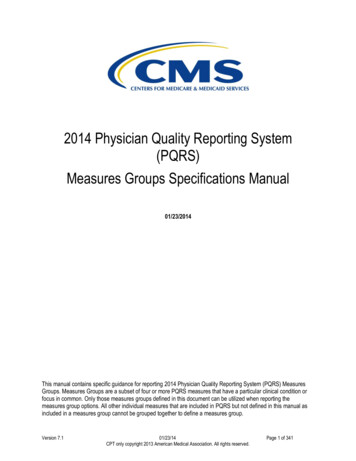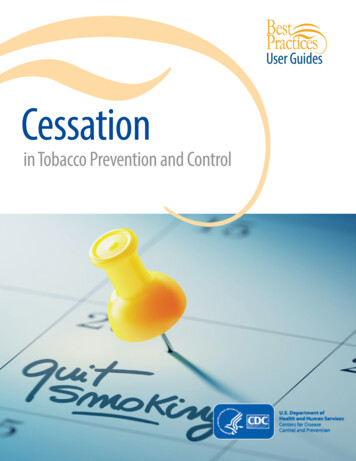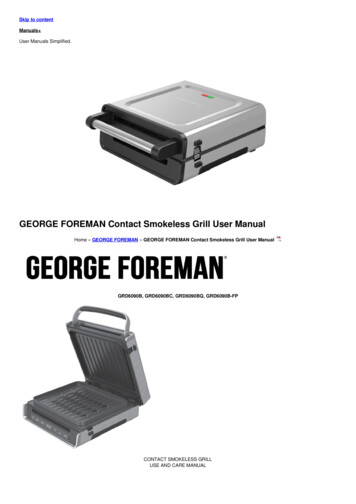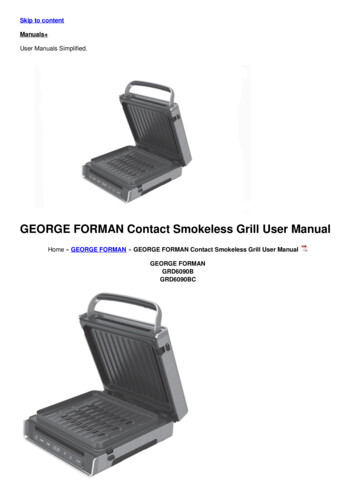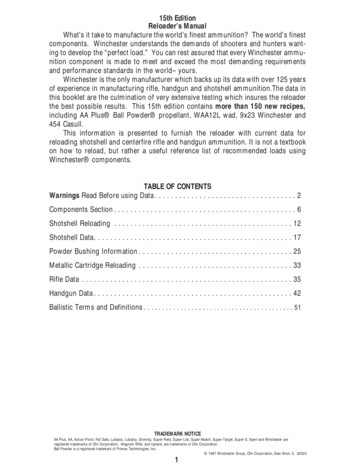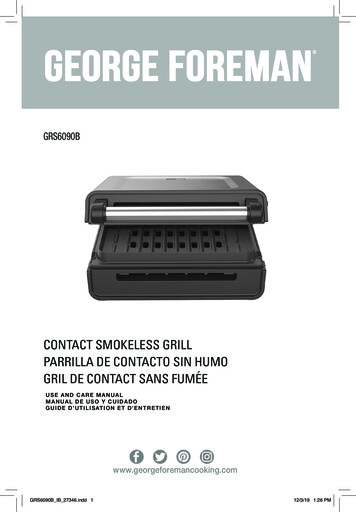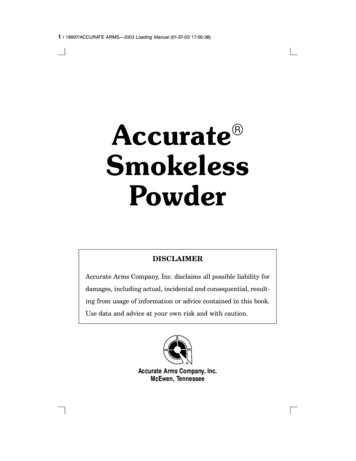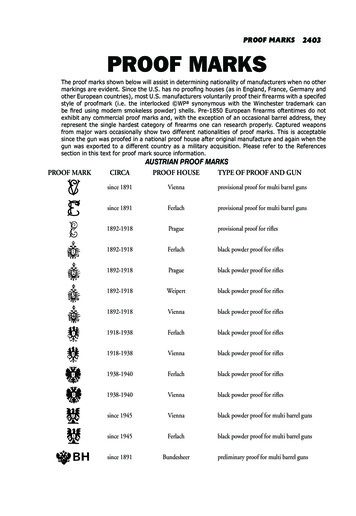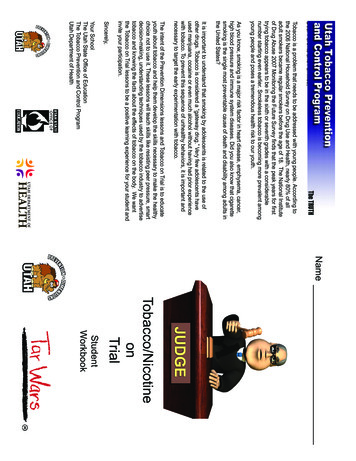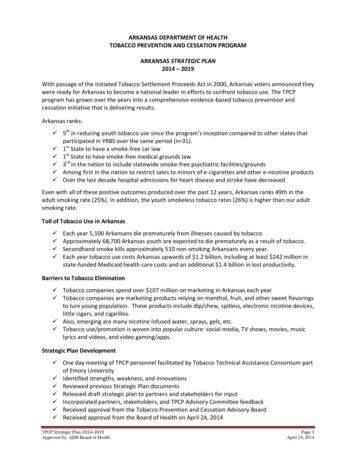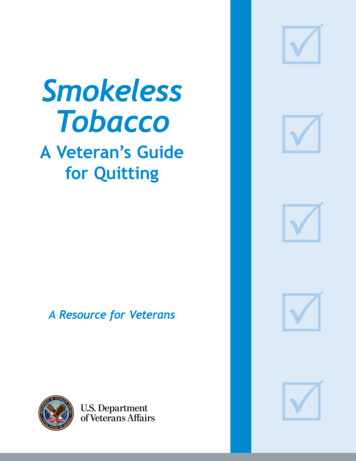
Transcription
SmokelessTobaccoA Veteran’s Guidefor QuittingA Resource for Veterans
Table of ContentsCHAPTER 1: Introduction. 1CHAPTER 2: Smokeless Tobacco and Addiction. 2CHAPTER 3: Your Reasons for Quitting. 4CHAPTER 4: Preparing to Quit. 8CHAPTER 5: Using Tobacco Cessation Medications. 12CHAPTER 6: Your First Two Weeks After Quitting:Coping With Withdrawal Symptoms & Triggers. 19CHAPTER 7: Celebrate Your Success and Stay Quit for Good!. 23AcknowledgementsSmokeless Tobacco: A Veteran’s Guide for Quitting was developedas a tobacco cessation resource for Veterans who use smokelesstobacco. Its primary purpose is to promote tobacco cessationinterventions, based on published principles of evidence- andconsensus-based clinical practice, for use by U.S. Department ofVeterans Affairs (VA) health care providers treating Veterans whouse smokeless tobacco.This guide was adapted from the National Institutes of Healthresource Smokeless Tobacco: A Guide for Quitting, created in2012. Many thanks to Dr. Kim Hamlett-Berry, Director of Tobacco& Health: Policy and Programs in Mental Health Services,Veterans Health Administration Office of Patient Care Services,for supporting this project; Dr. Tim Chen, Dr. Dana Christofferson,and Dr. Clint McSherry for their literature review, contentcontributions, and editing; Dr. Bradley Benedict, Dr. BruceCapehart, Dr. Julianne Himstreet, Dr. Cathy Williams-Sledge, andBridgette Vest for their thoughtful review and comments; andLeah Stockett for organizing and editing the guide.U.S. Department of Veterans AffairsVeterans Health AdministrationWashington, DC 20420Smokeless Tobacco:A Veteran's Guide for QuittingFebruary 2017
CHAPTER 1: IntroductionCHAPTER 1: IntroductionSO YOU USE CHEW OR DIP, AND YOU'D LIKE TO QUIT.Congratulations! You’re taking the first step to quitting tobacco. Perhaps you’velearned about the health risks of smokeless tobacco, or your doctor or dentistsuggested it would be good for you to quit. Maybe this is your first time trying toquit dip or chew, or maybe you've tried before and found that quitting is not easy.Quitting tobacco, any kind of tobacco, is a challenge. You can do it, and the U.S.Department of Veterans Affairs (VA) is here to help! This guide can help you makeyour own quit plan so you can quit for good.This guide includes recent research on the most effective ways to quit smokelesstobacco. Like most people who dip or chew, you may already know there are manyreasons to quit. Whether it is to improve your health, save money, or another reason,it is important to find your personal reasons for quitting, and use those reasons tomotivate you.1
CHAPTER 2: Smokeless Tobacco and AddictionCHAPTER 2: Smokeless Tobaccoand AddictionSmokeless tobacco contains 2,000 chemical compounds, including 30 cancer-causingchemicals such cificuraniumnitrosaminesTobacco-specific nitrosamines (TSNA) are by far the most harmful. TSNA levels insmokeless tobacco can be as much as 100X higher than other tobacco products.Smokeless tobacco includes dip, chew, moist snuff, and snus. All tobacco products,including smokeless tobacco, contain nicotine. Nicotine is the addictive part oftobacco and causes the pleasurable feelings some people get, but nicotine is not byitself harmful to your body. Dip and chewing tobacco actually contain more nicotinethan cigarettes, which may cause an even stronger addiction. Smokeless tobaccousers experience nicotine addiction differently from people who smoke cigarettes.With cigarettes, nicotine is delivered into the blood very quickly; but the nicotinelevel rapidly declines, causing withdrawal for the smoker and the urge to smokeanother cigarette. Dipping or chewing tobacco results in a slower and steadier rise inthe blood nicotine level, which remains higher for a longer period of time than whensmoking cigarettes.Keep in mind:Holdingan average-size dip in your mouth for 30 minutes gives you as muchnicotine as chain-smoking three cigarettes. A 2-can-a-week dipper gets as muchnicotine as a 1- to 1 ½-pack-a-day smoker.Here is a list comparing the nicotine levels of some selected smokelesstobacco brands:Nicotine levels of selected brands, from highest to lowest1. Grizzly Fine Cut Regular4. Kodiak Wintergreen2. Skoal Long Cut Regular5. Skoal Bandits Mint3. Copenhagen Long Cut6. Hawken Wintergreen* This list is provided for information only. VA does not endorse the use of anytobacco product.Thelevel of nicotine you get from dipping or chewing depends on the specificproduct you use, as well as the amount you use, how long you use it, and howoften you dip or chew.2
CHAPTER 2: Smokeless Tobacco and AddictionHOW ADDICTED ARE YOU?Think about your smokeless tobacco habit. Answer the questions below, and add upyour total score. This will give you an idea of how physically addicted you are to thenicotine in smokeless tobacco.1. How soon after you wake up do youplace your first dip?4. How many cans/pouches per weekdo you use?Within 5 minutes:3 pointsMore than 3:2 points6–30 minutes:2 points2–3:1 point31–60 minutes:1 point1:0 pointsAfter 60 minutes:0 points2. How often do you intentionallyswallow tobacco juice?Always:2 pointsSometimes:1 pointNever:0 points3. Which chew would you hate to giveup most? he first oneTin the morning:1 pointAny other:0 points5. Do you chew more frequentlyduring the first hours afterawakening than during the rest ofthe day?Yes:1 pointNo:0 points6. Do you chew if you are so ill thatyou are in bed most of the day?Yes:1 pointNo:0 pointsTOTAL: pointsScoring:High dependence (8 points)Moderate dependence (5–7 points) Low-to-moderate dependence (3–4 points)Low dependence (1–2 points)3
CHAPTER 3: Your Reasons for QuittingCHAPTER 3: Your Reasons for QuittingThere are multiple myths about smokeless tobacco, and sometimes these mythsmake users feel more comfortable in their habits.Myth: Smokeless tobacco is a harmless alternative to smoking.Truth: S mokeless tobacco is still tobacco. Smokeless tobacco often contains higherlevels of cancer-causing chemicals called nitrosamines. Note the healthwarning on smokeless tobacco cans.Myth: Good tooth and gum care can offset the harmful effects of using dip orchew.Truth: T here is no evidence that brushing and flossing will undo the harm that dipand chew are doing to your teeth and gums. Tobacco contains chemicalslike nitrosamines that cause oral cancer.Myth: It's easy to quit using dip or chew when you want to.Truth: U nfortunately, nicotine addiction makes quitting difficult. But those whohave successfully quit are very glad they did.Myth: Dip (or chew) improves athletic performance.Truth: A study of professional baseball players found no connection betweensmokeless tobacco use and player performance. Using smokeless tobaccoincreases your heart rate and blood pressure within minutes. This cancause a buzz or rush, but the rise in pulse and blood pressure places extrastress on your heart. Several Major League Baseball players are strongsupporters of quitting chew or snuff. In fact, many sports facilities havealso banned smokeless tobacco use.KICKING THE DIP OR CHEW HABIT CAN BE TOUGH; BUT IT CAN BEDONE, AND YOU CAN DO IT.The best approach to quitting tobacco is to understand your reasons for wanting toquit, pick a quit date, and come up with a quit plan. Your VA health care providercan help you develop a quit plan that may include medications, counseling, groups,or phone contacts. It’s up to you how you quit, and VA offers you a choice of manydifferent kinds of support.Know your reasons for quitting, and don't let outside influences like peer pressureget in your way. Remember to focus on everything you don't like about dippingand chewing.4
CHAPTER 3: Your Reasons for QuittingHEALTH EFFECTS OF DIPPING AND CHEWINGFor many people, their main reason for quitting is to prevent the negative healthproblems that smokeless tobacco can cause.Smokelesstobacco causes cancer of the mouth, esophagus, and pancreas.Smokelesstobacco may increase your risk of death from heart diseaseand stroke.Dippers/chewershave more dental problems than nonusers. Sugar in smokelesstobacco can cause cavities, chronic painful sores, and decay in exposedtooth roots.Dipand chew can cause your gums to pull away (recede) from the teeth inthe area where the tobacco is held, causing your teeth to become loose.Unfortunately, your gums will not grow back to where they were before, whichcan cause tooth loss.Dippersand chewers commonly get leathery white patches and red sores intheir mouths that can turn into cancer.Seeyour doctor right away for any early signs of oral cancer such as: a sore in your mouth that bleeds easily and does not heal a lump in your mouth or neck soreness or swelling that does not go away a white patch that does not go away trouble chewing, swallowing, or moving your tongue or jaw5
CHAPTER 3: Your Reasons for QuittingNEED MORE REASONS TO QUIT?It’sexpensive!With each can of dip costing an average of 4, a 2-can-a-week habitcosts 416 a year while a 1-can-a-day habit costs 1,460 a year! Likewise,chewing tobacco costs about 3 a pouch, so a 1-pouch-a-day habit costsmore than 1,000 a year. The cost adds up. Think about all the things youcould do with that money instead!ExampleMy ExperienceIf you use 2 cans per weekI use cans or pouches per week1 can costs 41 can or pouch costs 2 cans/week x 4 each 8 perweekcans or pouches/week x 8/week x 52 weeks a year 416spent each year per week x 52 weeks a year It’seach per week spent each yearnot attractiveChewing tobacco will stain your teeth and give you bad breath. Whileyou may become used to the odor, the smell of smokeless tobacco is notpleasant to others around you. Look at your teeth. Are they stained fromtobacco juice? Brushing your teeth won’t make this go away.TobaccojuiceFinding a place to spit tobacco juice isn’t always easy. Even when you havea cup, other people may not like seeing it, and it can spill. You can alsoaccidentally get juice on your clothes, furniture, and car upholstery, whichcan cause stains.6
CHAPTER 3: Your Reasons for QuittingMY REASONS FOR QUITTINGHere are some reasons people give for wanting to quit. Mark the reasons that areimportant to you: I want to avoid health problems like cancer, heart disease, dental problems,and addiction. I want to prove I can do it — I’ll feel better about myself. I have sores or white patches in my mouth. Someone I care about doesn’t like it. It’s important to me to set a good example for my kids or grandkids. I want to save money! I don’t like the taste. I have gum or tooth problems. It’s disgusting, and finding a place to spit is a hassle. It’s banned at my work or school. I don’t want it to control me — I want to be free of this addiction. My doctor or dentist told me quitting would improve my chance of living a long,healthy life. My doctor or dentist told me to quit because tobacco is causing Other reasons:7
CHAPTER 4: Preparing to QuitCHAPTER 4: Preparing to QuitPICK A QUIT DATEThere is no “ideal” time to quit, but low-stress times are best. Even if you thinkyou're ready to quit today, take some time to get ready. It’s best to pick a datein the next two weeks. Research shows that setting a specific date will help yoube successful.THIS IS MY QUIT DATEMONTH:DATE:YEAR:FILL IT IN!IDENTIFY YOUR TRIGGERSYou may use dip or chew in response to certain situations, or have particular places,people, or emotions that trigger a desire to use tobacco. Figuring out what makesyou want to chew or dip and how you’ll handle those things is a key part of preparingto quit. Take a look at the common triggers listed below, and identify which ones youexperience. Write in any of your triggers that are not listed. Waking up in the morning Waking up during the night orhaving nightmares Finishing meals Stress Taking breaks Pain Driving Feeling anxious, angry, or impatient Talking on the phone Seeing someone else dip or smoke Working on the computer8 Feeling bored Drinking coffee Watching TV Drinking alcohol Completing a task Having sex Playing a sport or watching a livegame or race Going to bed Going to a party
CHAPTER 4: Preparing to QuitThink about your biggest triggers and how you will avoid dipping or chewing whenone happens. Write down your strategy for handling your top three triggers below soyou can look back at them for support.MY THREE STRONGEST TRIGGERS ARE:Trigger #1:I will handle this trigger by:Trigger #2:I will handle this trigger by:Trigger #3:I will handle this trigger by:ADDITIONAL STRATEGIES TO HELP YOU PREPARE TO QUITTalkwith your VA health care provider or dentist about medicine to help youquit tobacco (see pages 13-19 for detailed information on these medications).Practiceyour strategies for coping without tobacco: Learn to put off a chew or dip. To do this, first figure out when yourcravings are strongest (see the list above for your personal triggers). Whenthese triggers occur, try to go at least 10 minutes before you use tobacco.As you approach your quit day, try going a longer amount of time witheach craving. Pick three of your strongest triggers, and stop dipping or chewing at thosetimes. It may be hard, but the time will come when you can go withouttobacco at the times when you most want it.Ifyou find it difficult to go for stretches of time without dipping or chewing, youmay want to try the following strategy for gradually cutting down the amount oftobacco you use each day: Find one or two activities that you can participate in without usingtobacco. Slowly add more situations or activities that you can do withouttobacco. Keep trying to go for longer periods of time before you dip orchew. This strategy will help to build your confidence and skills as you stopusing tobacco.9
CHAPTER 4: Preparing to QuitDON’Ts:Don’tcarry your tin or pouch with you. Leave it behind. Instead,carry substitutes like sugar-free chewing gum, sugar-free candies, andsunflower seeds, placing them in the same pocket where you usuallycarry your dip.Don’tswitch to other tobacco products like cigarettes, e-cigarettes, orcigars. In fact, if you already smoke, this is a good time to quit smokingas well. That way you can get over your nicotine addiction all at once.Don’tstart using products advertised as tobacco alternatives, such asherbal chews. Because these products are unregulated, you can’t besure what ingredients are in them. Also, there is no evidence that theseproducts can help you quit.Don’thang out with your dipping and chewing friends for a bit while youare trying to quit. That will help you avoid the urge to reach for a canor chew.GET HELP FROM VAVA has excellent programs that can help you quit, and some don’t require youto go anywhere for an appointment. VA’s tobacco quitline, 1-855-QUIT-VET(1-855-784-8838), has trained staff that can provide counseling, help you developa quit plan, and continue to support you throughout your quit effort. This counselingis available in English and Spanish.You can also sign up for VA’s text messaging program. You will receive text messagesof support, advice, and encouragement when you are quitting tobacco. You can signup for the program by texting the word VET to 47848 from your mobile phone orby visiting smokefree.gov/VET. You can text the keywords URGE, STRESS, and DIPPEDanytime to get an immediate tip for coping with an urge to use, stress, or a slip.Talk to your VA health care provider about quitting. Your provider can tell you aboutlocal resources for quitting and prescribe medications to help you quit.BUILD A SUPPORT TEAM — ENLIST THE PEOPLE YOU SEE EVERY DAYLet friends, family members, and co-workers know you're quitting. Warn them thatyou may not be your usual self for a week or two after you quit. Ask them to bepatient. Ask them to stand by to listen and encourage you when the going getsrough. If possible, give them specific suggestions on what they can do to help you sothey’ll know. Suggestions can include joining you for a run or a walk, helping you findways to keep busy, and telling you they’re willing to offer support when needed. Ifthey've quit tobacco, ask them for tips. If they use dip or chew, ask them not to offer10
CHAPTER 4: Preparing to Quityou any. They don't have to quit tobacco themselves to be supportive, but maybesomeone will want to quit with you.You can also find support online. Follow the SmokefreeVET Facebook page to connectwith a supportive community of Veterans who are also quitting tobacco.PLANNING FOR YOUR QUIT DAYMake your quit day special right from the beginning. For example, plan to stay busywith friends or family doing something you enjoy. Remember: You're doing yourself ahuge favor.Changedaily routines to break away from tobacco triggers. When you eatbreakfast, don't sit in the usual place at the kitchen table. Get right up from thetable after meals.Makean appointment to get your teeth cleaned. You'll enjoy the fresh, cleanfeeling and a whiter smile.Keepbusy and active. Start the day with a walk, run, swim, or workout. Aerobicexercise will help you relax. Plus, it boosts energy and stamina, improves yourall-around fitness, and curbs your appetite.Trysubstitutes like sugar-free hard candies or gum, cinnamon sticks, mints, beefjerky, or sunflower seeds. Carry them with you, and use them whenever youhave the urge to dip or chew.Spend11some time playing with your dog. Play fetch or go for a walk.
CHAPTER 5: Using Tobacco Cessation MedicationsCHAPTER 5: Using TobaccoCessation MedicationsThere are many types of medications used to help people quit tobacco. Some ofthese medications provide nicotine to help you slowly reduce the nicotine level inyour body when you quit. These medications, called Nicotine replacement therapy(NRT) will reduce your cravings for nicotine and help withdrawal symptoms.There are also two medications, bupropion (Zyban , Wellbutrin ) and varenicline(CHANTIX ), that do not contain nicotine but can help reduce your nicotine cravings.Each of these medications can be used for 2 to 6 months, and NRT and bupropionmay be used longer if needed. The medications listed below are available through VAby prescription.1. Nicotine replacement therapy (NRT)a. Nicotine patchb. Nicotine lozenge (includes nicotine mini-lozenges)c. Nicotine gum2. Bupropion (Zyban , Wellbutrin )3. Varenicline (CHANTIX )You may be wondering, “What's the best way to quit tobacco?” For people whosmoke cigarettes, research has found that using two tobacco cessation medicationsat once (called combination therapy) has the highest success rates for quitting. Lessis known about what medications work best for smokeless tobacco users, as therehas not been as much research. However, we’ve learned by helping patients quitsmokeless tobacco that smoking cessation medications approved by the U.S. Food andDrug Administration (FDA) provide smokeless tobacco users with relief from cravingsand withdrawal symptoms. As a user of smokeless tobacco, you can use combinationsof NRT or a combination of NRT and bupropion as noted below:nicotinepatch nicotine lozengenicotinepatch nicotine gumnicotinelozenge bupropionnicotinegum bupropionnicotinepatch bupropionNote: Varenicline is not used in combination with any other medication for quitting tobacco.12
CHAPTER 5: Using Tobacco Cessation MedicationsIf combination NRT is not effective or appropriate for you, you may want to talkwith your VA health care provider about using varenicline or bupropion. Based on theavailable research, varenicline appears to be more likely to help people quit usingsmokeless tobacco than bupropion. Bupropion may be effective but should be usedin combination with NRT for better results. Contact your VA health care provider ifyou are interested in using medications to help you quit tobacco so your provider candetermine which medications may be best for you.NICOTINE REPLACEMENT THERAPY (NRT)Nicotine patchHow is nicotine delivered into the body?Itis absorbed through the skin by wearing the patch.Where do I apply the patch?Applyto the skin on the upper arm, upper chest, or upper back; avoid using thesame area for a week to minimize possible skin irritation.Pressthe patch down firmly to get it to stick to your skin and rub for 10 to 15seconds to be sure it stays.Donot use lotion on your skin before applying the patch.Ifyour skin is oily, first use a cotton ball with rubbing alcohol to clean the area;then apply the patch when the skin is dry.Can I use tobacco when using the nicotine patch?Youshould try not to use tobacco when wearing the nicotine patch.Ifyou do have “slips” and use tobacco, continue wearing the nicotine patch andwork on using strategies (see page 23 to learn about the DEADS strategy) toavoid and resist using tobacco. After you remove the patch, there is still nicotinein your body for several hours.Ifyou go back to using tobacco regularly, stop using the nicotine patch.What are the possible side effects of the patch?Itchingor rash on the area where the patch is placed If this happens, try to put the patch on a different area of skin each day.13
CHAPTER 5: Using Tobacco Cessation MedicationsHivesor raised bumps If you get this, it might be that you are allergic to the adhesive portion ofthe patch. Stop using the patch, and contact your provider. Consider using a different brand of patch if available.Difficultysleeping or vivid dreams because the nicotine is being absorbed whenyou are sleeping If this happens, try removing the patch before you go to sleep.Nicotine lozengeHow is nicotine delivered into the body?Itis absorbed through the lining of the inside of your mouth, similar to the areawhere chewing tobacco is placed. Let the lozenge melt against your cheek andgums — this is the only way nicotine is absorbed from the lozenge.How do you use the nicotine lozenge?Placea lozenge in your mouth. Then, put it in the inside of your cheek, andleave it there. You can change the place where you put the lozenge to reduceirritation to your mouth.Donot chew or bite the lozenge. It must dissolve completely to release theentire dose of nicotine.Donot drink or eat for 15 minutes before using the lozenge, while using thelozenge, and for 15 minutes after using the lozenge. Avoid acidic beverages likecoffee, juice, soda, and alcohol during these times because they will reduce theabsorption of the nicotine from the lozenge.you are using nicotine lozenges in combination with nicotine patches orbupropion (Zyban , Wellbutrin ):If Use one lozenge when you have a craving for tobacco or at times when youknow you have strong cravings. You may use up to 10 to 12 lozenges per day if needed and then reduceeach week as directed by your provider. When you step down to a lower strength patch, you may have additionalcravings. At that time, you can always increase lozenge use if needed andthen reduce thereafter.14
CHAPTER 5: Using Tobacco Cessation MedicationsWhat are possible side effects* of the lozenge?Irritationof the mouthHiccupsNauseaand heartburn if chewed or swallowed*Side effects are likely due to using the nicotine lozenge incorrectly.Nicotine gumHow is nicotine delivered into the body?Itis absorbed through the lining of the inside of your mouth, similar to thearea where chewing tobacco is placed. Let the gum sit against your cheek andgums — this is the only way nicotine is absorbed from the gum.How do you use nicotine gum?Usethe “chew and park” method. Place a piece of gum in your mouth and chewit several times until you get a peppery taste or a tingling sensation. Park thegum in the inside of your cheek, and leave it there until you no longer have thepeppery taste or the tingling. Repeat the “chew and park” method several timesuntil there is no longer a peppery taste to the gum. Then throw out the gum.Avoidchewing nicotine gum like regular chewing gum. Using nicotine gum thisway will not allow the nicotine to be absorbed through the lining of your mouth.Also, swallowing the nicotine gum may cause you to feel sick to your stomachand get heartburn. You may also notice that the nicotine craving will not goaway, since nicotine is not absorbed through your stomach. Avoid combiningregular chewing gum with nicotine gum. This will reduce the absorption ofnicotine from the NRT gum.Donot drink or eat for 15 minutes before using the gum, while using the gum,and for 15 minutes after using the gum. Avoid acidic beverages like coffee, juice,soda, and alcohol during these times because they will reduce the absorption ofnicotine from the gum.you are using nicotine gum in combination with nicotine patches orbupropion (Zyban , Wellbutrin ):If Chew one piece of gum when you have a craving for tobacco or at timeswhen you know you have strong cravings. You may use up to 10 to 12 pieces of gum per day if needed and thenreduce each week as directed by your provider. When you step down to a lower strength patch, you may have additionalcravings. At that time, you can always increase gum use if needed and thenreduce thereafter.15
CHAPTER 5: Using Tobacco Cessation MedicationsWhat are possible side effects* of the gum?Irritationof the mouthHiccupsNauseaand heartburn if chewed quickly and swallowed*Side effects are likely due to using the nicotine gum incorrectly.Bupropion (Zyban , Wellbutrin )How does bupropion work?Bupropion reduces nicotine cravings by increasing the chemical dopamine in thebrain. Bupropion does not contain nicotine so you may experience some nicotinewithdrawal symptoms. Bupropion is also an antidepressant, which can be beneficialfor some people who use tobacco and have a history of depression.Who should NOT use bupropion?Ifyou have a history of seizures, bupropion can increase your seizure risk.Ifyou currently have an eating disorder like anorexia or bulimia, bupropion canincrease your seizure risk.Ifyou drink more than two servings of alcohol a day (one serving is 12 ounces ofbeer, 6 ounces of wine, or 1 ounce of hard alcohol), bupropion can increase yourseizure risk if you quit alcohol abruptly.If you are currently taking medication for depression, bipolar disorder, or othermental health disorders, you should discuss with your psychiatrist or doctor ifbupropion will work with your current medications.Can bupropion be used in combination with other medications to helpquit tobacco?Bupropion can be used in combination with the nicotine patch, nicotine gum, andnicotine lozenges.What are the possible side effects when using bupropion?Mostcommon Difficulty sleeping Nervousness Dry mouth16
CHAPTER 5: Using Tobacco Cessation MedicationsLesscommon Rash or swelling (If you get this, you might be allergic to the medication.Contact your doctor if these side effects occur.)In rare occasions, you may experience mood changes, depression, or suicidal orhomicidal thoughts. Contact your doctor if you experience any of these seriousside effects.If you are in crisis, call the Veterans Crisis Line at 1-800-273-8255 and press 1 totalk to someone immediately, send a text message to 838255, or chat online atwww.VeteransCrisisLine.net.Varenicline (CHANTIX )How does varenicline work?Varenicline blocks the receptor in the brain where nicotine binds so you don’t feelits effects when you use tobacco. Varenicline also acts like a weak form of nicotine,which can help reduce nicotine withdrawal symptoms.Who should consider using varenicline?If you have experienced one or more of the following situations, you may want to talkto your VA health care provider about using varenicline as part of your treatment. You previously tried using nicotine replacement therapy (NRT), bupropion,or combination NRT, and it was not effective. You previously quit tobacco with varenicline but started usingtobacco again. You had difficulty tolerating NRT or bupropion or have medicalcontraindications to these medications.Who should NOT take varenicline?Ifyou have a history of serious hypersensitivity or skin reactions withvarenicline, you should not use it.Ifyou have a history of suicidal thoughts or acts in the past 12 months,you should talk with your mental health provider or doctor about whethervarenicline is appropriate for you. This is important as there have been rarereports of mood changes, depression, and suicidal ideation or intent amongsome patients.17
CHAPTER 5: Using Tobacco Cessation MedicationsAdditional issues to consider with vareniclineIf you have a history of seizures, have heart problems, or use alcohol, please consultyour VA health care provider before starting this medication. The FDA found somecases of seizure in people taking varenicline, with most cases occurring in the firstmonth of therapy. Varenicline also appears to lower some patients’ tolerance foralcohol, so you may want to drink less alcohol until you know how you will toleratealcohol while on this medication.Can varenicline be used in combination with other medications to help stoptobacco use?No, varenicline is not used in combination with NRT or bupropion. NRT is notexpected to be effective because varenicline blocks the nicotine receptors. Limitedstudies are available looking at varenicline in combination with bupropion. If you arealready on bupropion for mood or other uses, varenicline can be considered. Discusswith your VA health care provider if the medication can still be used with bupropion.What are the possible side effects of varenicline?Most common side effects include:Upsetstomach, nausea, vomiting — these are mostly avoided by taking themedicine with food and a full glass of waterHeadacheDifficultysleeping, dream disturbancesThere have been rare reports of mood changes including depression, suicidalthoughts,
supporters of quitting chew or snuff. In fact, many sports facilities have also banned smokeless tobacco use. KICKING THE DIP OR CHEW HABIT CAN BE TOUGH; BUT IT CAN BE DONE, AND YOU CAN DO IT. The best approach to quitting tobacco is to understand your reasons for wanting
